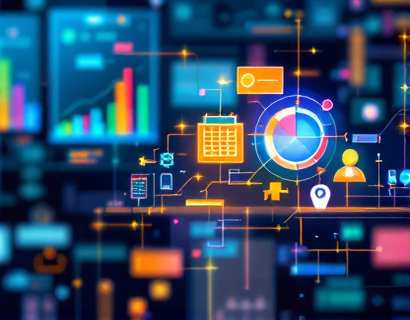Transforming Healthcare Access Through AI-Powered Chat Interfaces
In the rapidly evolving landscape of healthcare, the integration of artificial intelligence (AI) is revolutionizing how medical information is accessed and understood. An AI-driven chat interface stands at the forefront of this transformation, offering a unique blend of accuracy, safety, and accessibility. This technology is particularly transformative for healthcare professionals, medical students, parents, educators, and the general public seeking specialized medical knowledge. By leveraging advanced AI algorithms, these chat interfaces provide verified information, ensuring users receive reliable insights into various aspects of healthcare services and industry knowledge.
Enhancing Professional Development and Patient Education
For healthcare professionals, staying updated with the latest medical advancements and best practices is crucial. An AI chat interface serves as an invaluable tool for continuous learning, offering quick access to specialized medical knowledge. Whether it's the latest research findings, treatment protocols, or industry regulations, professionals can engage in real-time conversations to deepen their understanding and enhance their practice. This immediate access to verified information not only boosts professional competence but also improves patient care by ensuring practitioners are well-informed.
For medical students, such a platform is a gateway to exploring complex medical concepts in an interactive and engaging manner. The AI chat interface can simulate conversations with experts, providing explanations, answering queries, and offering insights that complement traditional learning methods. This approach not only aids in knowledge acquisition but also fosters critical thinking and problem-solving skills essential for future healthcare providers.
Ensuring Safety and Accuracy in Medical Information
A critical aspect of any healthcare information platform is the assurance of content accuracy and safety. Misinformation in healthcare can have severe consequences, making it imperative to have a system that verifies all information before dissemination. The AI chat interface employs rigorous content verification processes, cross-referencing data from credible sources to ensure the information provided is up-to-date and accurate. This commitment to accuracy builds trust among users, whether they are professionals seeking reliable data or patients looking for trustworthy health information.
Moreover, the chat interface is designed with user safety in mind. It filters out any potentially harmful or misleading content, creating a secure environment for all users. This feature is particularly important for children and students who may inadvertently access sensitive medical information. By maintaining a safe and controlled interaction, the platform ensures that users, especially the younger demographic, can explore medical knowledge without exposure to inappropriate content.
Child-Friendly Exploration of Medical Knowledge
Recognizing the need for educational resources that cater to children and students, the AI chat interface offers a child-friendly version. This version simplifies complex medical terms and concepts, making them accessible and understandable for young minds. The language used is age-appropriate, and the content is structured to be engaging and interactive, encouraging curiosity and learning. Parents and educators can rest assured that their children are accessing educational material that is both safe and informative.
The child-friendly version also includes visual aids and simplified explanations, enhancing the learning experience. For instance, when a child asks about a particular disease, the chat can provide a brief overview, accompanied by illustrations or simple diagrams, to help them grasp the concept better. This approach not only educates but also demystifies healthcare, making it less intimidating for young learners.
Facilitating Informed Decision-Making for Patients
Patients play a vital role in their healthcare journey, and having access to accurate information empowers them to make informed decisions. The AI chat interface serves as a valuable resource for patients seeking to understand their conditions, treatment options, and preventive measures. By engaging in a conversational format, patients can ask specific questions and receive detailed, personalized responses. This interaction helps demystify medical jargon and provides clarity on complex topics, fostering a better patient-provider relationship and improving overall health outcomes.
Moreover, the chat interface can guide patients through the healthcare system, helping them navigate appointments, understand insurance coverage, and manage their health records. This comprehensive support system ensures that patients are well-informed and prepared, reducing anxiety and enhancing their healthcare experience.
Supporting Healthcare Professionals in Various Roles
Healthcare professionals encompass a wide range of roles, from doctors and nurses to pharmacists and administrative staff. Each role requires access to specific types of medical information, and the AI chat interface caters to these diverse needs. For instance, a nurse looking for up-to-date guidelines on infection control can have a detailed conversation with the chat, receiving step-by-step protocols and best practices. Similarly, a pharmacist seeking information on drug interactions can get precise and current data, ensuring safe prescribing practices.
The chat interface also supports specialists by providing in-depth knowledge on their specific areas of expertise. For example, a cardiologist can engage in discussions about the latest advancements in heart disease treatment, while a pediatrician can access resources on child health and development. This specialized access ensures that professionals can stay current with the latest research and clinical practices, enhancing their ability to provide top-notch care.
Enhancing Collaboration and Communication in Healthcare
Effective communication and collaboration among healthcare providers are essential for delivering high-quality care. The AI chat interface facilitates this by serving as a common platform where professionals can share insights, discuss cases, and collaborate on patient care plans. The chat can store and retrieve previous conversations, providing a historical context for ongoing discussions. This feature is particularly useful in multidisciplinary teams where multiple specialists need to be on the same page.
Additionally, the chat interface can integrate with electronic health records (EHRs), allowing seamless access to patient data. This integration ensures that discussions are informed by the most current and relevant information, reducing the risk of errors and improving patient safety. The chat can also send reminders and alerts for follow-up actions, ensuring that all team members are aware of their responsibilities and deadlines.
Addressing the Digital Divide in Healthcare Access
Despite the numerous benefits of AI-powered chat interfaces, it is crucial to address the digital divide that can limit access to these tools. To ensure equitable access, efforts should be made to provide this technology in various settings, including rural clinics, community health centers, and public libraries. Mobile-friendly designs and offline capabilities can further enhance accessibility, ensuring that even those with limited internet connectivity can benefit from the platform.
Moreover, training programs can be implemented to educate healthcare providers and patients on how to effectively use the chat interface. These programs can be tailored to different user groups, considering their unique needs and technological proficiency. By promoting digital literacy, the healthcare community can ensure that everyone has the opportunity to leverage these advanced tools for better health outcomes.
Future Prospects and Innovations
The potential for AI-powered chat interfaces in healthcare is vast, with ongoing advancements promising even more sophisticated and personalized interactions. Future developments may include the integration of natural language processing (NLP) to better understand and respond to user queries, enhancing the chat's conversational capabilities. Machine learning algorithms can be trained to recognize patterns in user interactions, allowing the chat to provide more tailored and predictive responses over time.
Another exciting prospect is the incorporation of emotional intelligence into the chat interface. By detecting and responding to users' emotional states, the chat can offer empathetic support, which is particularly valuable in sensitive healthcare conversations. This emotional awareness can help build stronger connections between users and the platform, fostering trust and satisfaction.
Furthermore, the chat interface can be expanded to include telehealth capabilities, enabling virtual consultations and remote monitoring. This integration would allow users to not only seek information but also receive real-time guidance from healthcare professionals, bridging the gap between physical and digital healthcare services. Such innovations have the potential to revolutionize healthcare delivery, making it more accessible, efficient, and patient-centered.
In conclusion, AI-powered chat interfaces represent a significant leap forward in healthcare access and education. By providing verified, specialized medical knowledge in an engaging and safe manner, these platforms empower professionals, students, and the public alike. The child-friendly version ensures that even the youngest learners can benefit from this technology, while the support for healthcare professionals and patients enhances the overall quality of care. As this technology continues to evolve, it holds the promise of transforming healthcare into a more informed, collaborative, and patient-centric field.











































